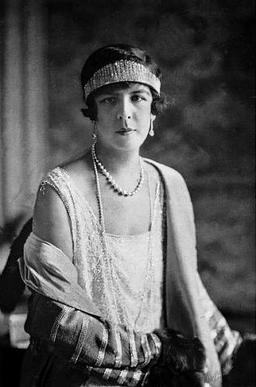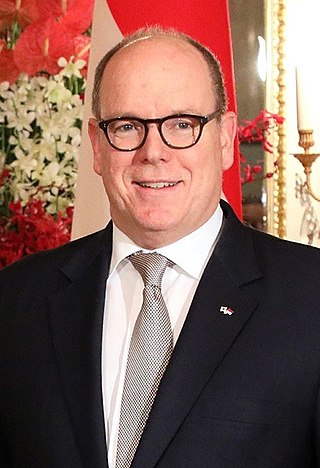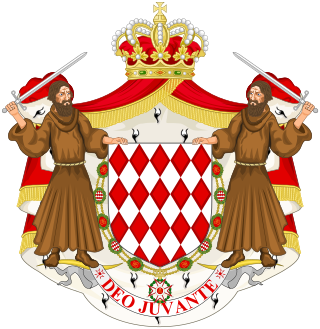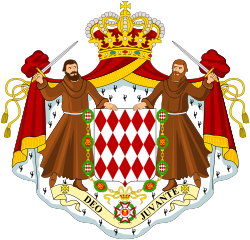
The Arms of Canada, also known as the Royal Coat of Arms of Canada or, formally, as the Arms of His Majesty the King in Right of Canada, is the arms of dominion of the Canadian monarch and, thus, also the official coat of arms of Canada. In use since 1921, it is closely modelled after the royal coat of arms of the United Kingdom, with French and distinctive Canadian elements replacing or added to those derived from the British version.

Princess Charlotte, Duchess of Valentinois, styled Hereditary Princess of Monaco between 1922 and 1944, was the daughter of Louis II, Prince of Monaco, and the mother of Prince Rainier III. From 1922 until 1944, she was the Hereditary Princess of Monaco, heiress presumptive to the throne.

A saltire, also called Saint Andrew's Cross or the crux decussata, is a heraldic symbol in the form of a diagonal cross. The word comes from the Middle French sautoir, Medieval Latin saltatoria ("stirrup").

Albert II is Prince of Monaco, reigning since 2005.

The national flag of the Principality of Monaco has two equal horizontal bands, of red (top) and white (bottom), both of which have been the heraldic colours of the House of Grimaldi since at least 1339. The present bicolour design was adopted on 4 April 1881, under Charles III.

The coat of arms of Belgium bears a lion or, known as Leo Belgicus, as its charge. This is in accordance with article 193 of the Belgian Constitution: The Belgian nation takes red, yellow and black as colours, and as state coat of arms the Belgian lion with the motto UNITY MAKES STRENGTH. A royal decree of 17 March 1837 determines the achievement to be used in the greater and the lesser version, respectively.

The House of Grimaldi is the current reigning house of the Principality of Monaco. The house was founded in 1160 by Grimaldo Canella in Genoa and became the ruling house of Monaco when Francesco Grimaldi captured Monaco in 1297. The House of Grimaldi has produced every Prince of Monaco. During much of the Ancien Régime, the family resided in the French court, where from 1642 to 1715 they used the title of Duke of Valentinois.

The current coat of arms of Zimbabwe was adopted on 21 September 1981, one year and five months after the national flag was adopted. Previously the coat of arms of Zimbabwe was identical to the former coat of arms of Rhodesia.

The coat of arms of Sunderland is the official heraldic arms of the City of Sunderland in England.

The sovereign prince is the monarch and head of state of the Principality of Monaco. All reigning princes have taken the name of the House of Grimaldi, although since 1731 have belonged to other families in the male line. When Prince Rainier III died in 2005, he was Europe's longest reigning monarch. The Grimaldi family, which has ruled Monaco for eight centuries, is Europe's longest-ruling royal family.

The coat of arms of Monaco, referred to also as an armorial achievement or an arms of dominion, is the symbolic representation of the House of Grimaldi, the current sovereigns of the principality of Monaco.

The flag of the British Antarctic Territory was granted on 21 April 1998. It features the coat of arms granted on 1 August 1963, a year after the British Antarctic Territory, a British Overseas Territory, was created. Previously, the Territory was a part of the Falkland Islands Dependencies and used the same flag. On 30 May 1969, a blue ensign with the British Antarctic Territory coat of arms in the fly was introduced as a civil ensign.

Portuguese heraldry encompasses the modern and historic traditions of heraldry in Portugal and the Portuguese Empire. Portuguese heraldry is part of the larger Iberian tradition of heraldry, one of the major schools of heraldic tradition, and grants coats of arms to individuals, cities, Portuguese colonies, and other institutions. Heraldry has been practiced in Portugal at least since the 12th century, however it only became standardized and popularized in the 16th century, during the reign of King Manuel I of Portugal, who created the first heraldic ordinances in the country. Like in other Iberian heraldic traditions, the use of quartering and augmentations of honor is highly representative of Portuguese heraldry, but unlike in any other Iberian traditions, the use of heraldic crests is highly popular.

In heraldry and heraldic vexillology, a blazon is a formal description of a coat of arms, flag or similar emblem, from which the reader can reconstruct the appropriate image. The verb to blazon means to create such a description. The visual depiction of a coat of arms or flag has traditionally had considerable latitude in design, but a verbal blazon specifies the essentially distinctive elements. A coat of arms or flag is therefore primarily defined not by a picture but rather by the wording of its blazon. Blazon is also the specialized language in which a blazon is written, and, as a verb, the act of writing such a description. Blazonry is the art, craft or practice of creating a blazon. The language employed in blazonry has its own vocabulary, grammar and syntax, which becomes essential for comprehension when blazoning a complex coat of arms.

The coat of arms of Kropyvnytskyi is one of the city's symbols reflecting its past and the controversies of its history.

The coat of arms of the Extremadura is described in the Title I of the Spanish Law 4 of June 3, 1985, the Law of the coat of arms, flag and regional day of Extremadura.
Liechtenstein heraldry is the form of heraldic art found in the country of Liechtenstein. It does not have a heraldic body of its own, relying on primarily German influences through the ruling house. It follows the German-Nordic tradition.
Maltese heraldry is the design, display, and study of armorial bearings as used in the traditions of Malta.

A number of cross symbols were developed for the purpose of the emerging system of heraldry, which appeared in Western Europe in about 1200. This tradition is partly in the use of the Christian cross an emblem from the 11th century, and increasingly during the age of the Crusades. Many cross variants were developed in the classical tradition of heraldry during the late medieval and early modern periods. Heraldic crosses are inherited in modern iconographic traditions and are used in numerous national flags.

The Treaty of Stupinigi was signed on November 8th and 10th 1817, in Stupinigi between Honoré V, Prince of Monaco, and Victor Emmanuel I of Sardinia.
















